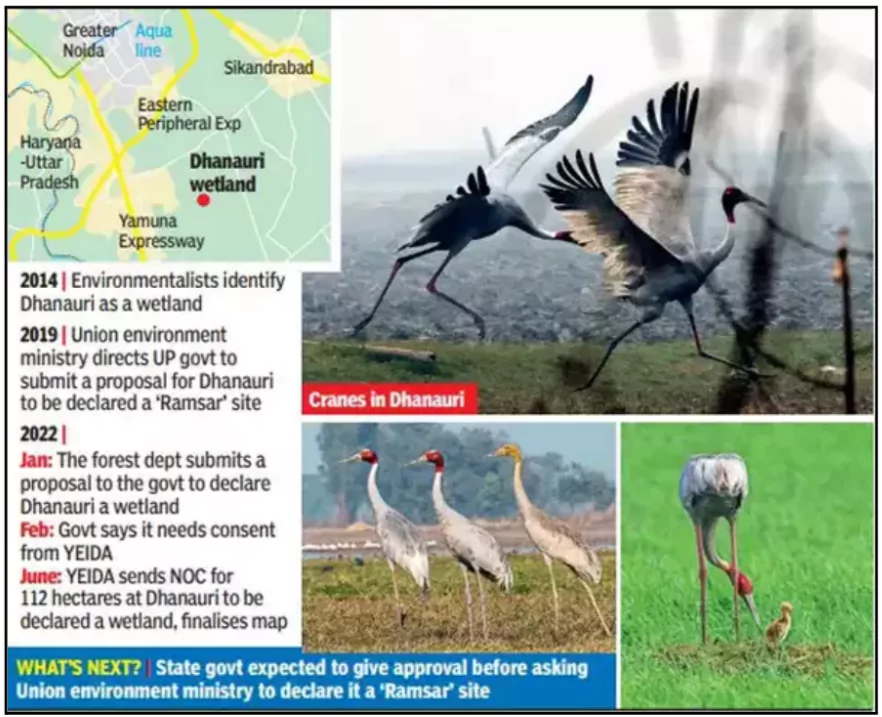NGT asks UP government why the proposal to notify Dhanauri wetland as a Ramsar site has not been sent to the Centre.
About Dhanauri Wetland

- It is a Bird-watching area located in Dhanauri village near Dankaur in Uttar Pradesh.
- The wetland is already home to 217 bird species.
- During peak migratory seasons, between November and March, the population of waterfowl reaches up to 50,000.
- It is home to around 150 Sarus Crane which is also the State Bird Of Uttar Pradesh.
- It has received recognition as an Important Bird Area by Bird Life International and has been documented by the BNHS (Bombay Natural History Society).
Enroll now for UPSC Online Course
Ramsar Site Designation Criteria
- Representing rare or unique natural wetland types.
- Supporting endangered species or threatened ecological communities.
- Maintaining biodiversity in specific biogeographic regions.
- Offering refuge during adverse conditions.
- Regularly accommodating 20,000 or more waterbirds.
- Sustaining 1% of a population of a single water-bird species.
- Serving as a critical source of food, spawning grounds, nurseries, and migration paths for fish.
- Regularly supporting 1% of a population of non-avian wetland-dependent animal species
Dhanauri wetland fulfils two key Ramsar site criteria out of nine
- It hosts over 1% of the biogeographic Sarus crane population.
- The area serves as a congregation site for 20,000+ waterfowls and various other species.
What is a wetland ?
- Ramsar Convention on Wetlands defines wetlands as “Areas of marsh, fen, peat land or water, whether natural or artificial, permanent or temporary, with water that is static or flowing, fresh, brackish or salt, including areas of marine water the depth of which at low tide does not exceed six metres.”
- Comprise areas that transition between terrestrial (land) areas and aquatic (water) areas.
Check Out UPSC NCERT Textbooks From PW Store
Ramsar Convention
- Named after Ramsar in Iran where the convention was ratified in 1971 which came into force in 1975.
- Three pillars of the Convention are:
-
- Work towards the wise use of all their wetlands.
- Designate suitable wetlands for the list of Wetlands of International Importance (the “Ramsar List”) and ensure their effective management.
- Cooperate internationally on transboundary wetlands, shared wetland systems and shared species
Ramsar Sites of India
- As of August 2024, India has 85 Ramsar sites which is highest in South Asia.
- Tamil Nadu with 18 sites has the most Ramsar sites in India followed by Uttar Pradesh with 10 sites.
- These sites play a crucial role in supporting biodiversity, protecting endangered species, and ensuring sustainable use of water resources.
- The addition of Dhanauri to this prestigious list would further solidify India’s commitment to wetland conservation, supporting its diverse birdlife and ecosystems.
Montreux Record
- Maintained as part of the Ramsar List.
- Register of wetland sites on the List of Wetlands of International Importance where changes in ecological character have occurred, are occurring, or are likely to occur as a result of technological developments, pollution or other human interference.
- Two wetlands in India are currently on the Montreux Record:
- Keoladeo National Park; Rajasthan
- Loktak Lake; Manipur
Enroll now for UPSC Online Classes
![]() 26 Sep 2024
26 Sep 2024

